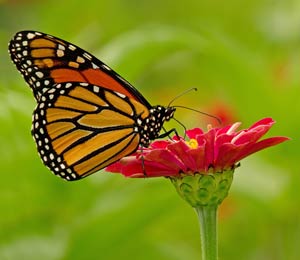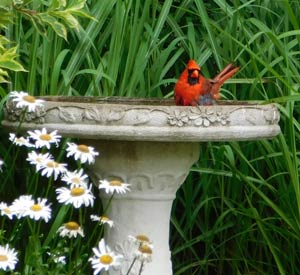3 D's of Successful Backyard Habitat
1. DIVERSITY
Many wildlife species rely on a diversity of habitat to survive. Variety is key to establishing good habitat. The more variety your yard or neighborhood can provide in a small area, the more wildlife you can expect to attract. Diversity includes providing all the habitat components that wildlife needs in your yard - food, water, shelter, and nesting habitat.
Food Sources for Backyard Animals

Food can be provided in a variety of ways. As you look around your property, think like the wildlife you want to attract. Is there enough food year-round to meet their needs? Are there flowers for nectar, weeds for seeds, shrubs and trees for fruit or acorns?
Nectar plants, such as butterfly weed, butterfly bush, cardinal flowers, asters, and zinnias, attract butterflies and hummingbirds. Even "weeds" such as goldenrod, chicory, pokeweed, thistle, and honeysuckle are beneficial nectar producers. Clovers can provide sustenance for cottontails.
Leaving leaves, mulching plants, using compost, and minimizing pesticide use benefits those wildlife species which rely on insects and invertebrates as food. Learn about the benefits of not raking..
- Artificial feeders. Do you need artificial feeders to attract birds, squirrels, deer, or butterflies? For birds, the types of feeders and seeds you provide will attract certain species. Oil sunflower seeds attract cardinals, chickadees, purple finches, goldfinches, white-throated sparrows, and even woodpeckers. Sunflower chips, husked peanuts, or hulled seeds may be an option for apartment dwellers where discarded hulls could create a problem. Fruit such as raisins, orange halves, grapes, and apples attract mockingbirds, orioles, catbirds, and tanagers. Suet and mealworm feeders attract woodpeckers and bluebirds, respectively, as well as raccoons and other wildlife species. Corn feeders attract deer and squirrels, though be careful about attracting too many! They may also eat your preferred landscape plantings and raid bird feeders.
Read about feeding backyard birds
Water Sources are Key to a Healthy Backyard Habitat

Water is important for drinking, bathing, even egg-laying for frogs, toads, and insects. Water depth of 1/2" is needed for smaller birds, while larger birds can use 1" to 2" depth. Placement of feeders and water sources should be carefully considered, such that there is enough open space to see an approaching predator, yet protective habitat is available close by.
Wildlife needs water in the winter as well. Keep a piece of wood in the water to prevent freezing and thawing actions from cracking your birdbath or other water container.
Cover or Shelter for Animals
In your yard, also consider that wildlife needs shelter for protection against, rain, snow, ice, sun, wind, and predators. Dense evergreens, large broad-leaved shrubs and trees, thick grasses, and brush piles provide protective cover for a number of birds and mammals. Mockingbirds build nests in shrubs, while barn swallows use barns, outbuildings, or open garages as places to construct their mud nests.
You can expand your nesting habitat with artificial nest boxes for songbirds, bats, and owls.
Several key factors make a good birdhouse:
- It should be built of wood, have an entry hole at least 6" above floor
- have an overhanging roof to keep rain from the entrance
- contain ventilation holes or slits
- provide an easy way to open for cleaning
- have a hook or devise to hang the box
- be the right dimensions for the species of interest
- be placed in the proper location for the species you're attracting
2. DESIGN
Besides diversity, designing your yard properly will benefit wildlife and improve viewing opportunities.
- Design your yard to create vistas for seeing wildlife near windows and decks.
- Place feeders and nest boxes in locations that are visible from your home.
- Use varied heights of vegetation, with taller shrubs and trees placed around the border of your yard.
- Plant multiple species of plants. Create natural effects by planting in groups of 3, 5, or 7.
- Design curved (not straight) borders.
- And be sure to plan for year-round beauty and habitat needs.
3. DILIGENCE
Be diligent in maintaining your habitat.
- Some plantings may die and need to be replaced.
- "Weeding" may be necessary to control successful plantings which, without thinning, could take over the yard.
- Bird boxes need to be cleaned.
- Water needs to be periodically drained and containers sanitized.
Download our publication for 12 Wildlife Habitat Tips for Small Acreages
###
By Sherri Sanders
White County Extension Agent - Agriculture
The Cooperative Extension Service
U of A System Division of Agriculture
White County Cooperative Extension Service
2400 Old Searcy Landing Road Searcy AR 72143
(501) 268-5394
ssanders@uada.edu